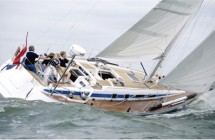
This story need to be shared. What about finding your dreamyacht and make it yours ?
The story about an an abandoned Swan 48 floating around south of Bermuda has created some buzz it seems and numerous people are now making noises about retrieving it. To help inform and inspire would-be salvagers, I thought I should share some of what I know about these boats. I’ve sailed them back and forth between New England and Caribbean several times and have also raced a bit on them—around the cans and in one Bermuda Race.
You know, of course, that Nautor Swan of Finland, founded originally by Pekka Koskenkyla, has an excellent reputation. They’ve been building high-end production fiberglass sailboats for over 40 years, most of them what I’d call cruiser-racers. Most older Swans have sleek, modern hull forms, according to the era in which they were built, but they are also a bit heavy, as they are very solidly constructed with teak decks and lots of heavy solid-teak interior joinery.
The traditional Swan zeitgeist ended in 1998 when Nautor was acquired by the Italian fashion magnate Leonardo Ferragamo. Since then new Swans have been either luxury performance cruisers 70 feet and longer or smaller (45 feet or less) flat-out racing yachts. The German Frers-designed Swan 48, which was first introduced in 1995 and was discontinued in 2004 after a production run of 57 hulls, is one of the last of the old breed.
Unlike most (but not all) of the pre-Ferragamo Swans, the 48 was available either as a “regatta” racer or as a straight “cruiser-racer.” The regatta version features a deeper high-aspect keel (9’6″ as opposed to 7’11″) and a taller 7/8 rig (1,241 sq. ft.) and is almost 6,000 pounds lighter, thanks mostly to a simplified interior that is still, by modern race-boat standards, a bit heavy on the teak. The cruiser-racer was offered with two optional sail plans–a mildly fractional (15/16) rig (1,168 sq. ft.) and a straight masthead rig (1,142 sq. ft.). It also features a fold-down transom with built-in steps. Both boats have the same basic construction. The hull is solid laminate composed mostly of unidirectional hybrid glass/aramid fibers set in polyester resin. The deck is also a glass/aramid laminate set in polyester over a Divinycell foam core with high-density core inserted under deck fittings. The teak deak overlay is glued and vacuum-bagged in place with no penetrating fasteners.
As with many pre-Ferragamo Swans, the 48′s deck layout is somewhat idiosyncratic. The cockpit is split with two separate companionways and two separate working areas. The midship cockpit, little more than a shallow footwell, has all halyards, reefing lines, spinnaker–pole controls, etc.–a total of 11 lines–led through organizers and clutches to a single pair of winches on either side of the main companionway, making this a busy area. All sheets (as well as a pair of running backstays) are led to the aft cockpit. The mainsheet is double-ended and can be controlled either from the aft companionway or from the helm, which is a handy feature. Ultimately, however, because the controls are so spread out, this is not an easy boat for one or even two people to sail. Things work best when there are at least three people on deck.
For more pictures : http://www.wavetrain.net/boats-a-gear/464-swan-48-definitely-worth-salvaging
